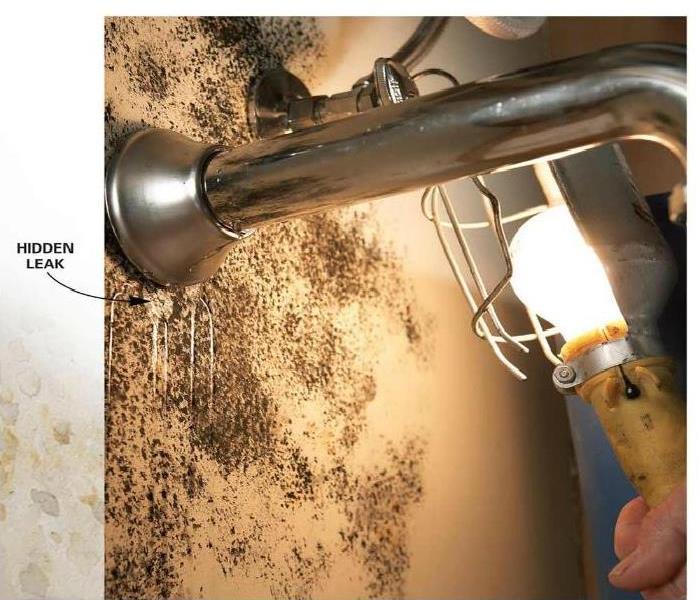10 Tips for Removing Mold and Mildew
3/2/2017 (Permalink)
 If you see mold near water pipes, waste lines, ice maker lines or plumbing fixtures, chances are the mold is feeding off a nearby leak.
If you see mold near water pipes, waste lines, ice maker lines or plumbing fixtures, chances are the mold is feeding off a nearby leak.
Although we would prefer to call the pros, SERVPRO of Benton, Newton, Jasper & Southern Lake Counties, here are some DIY hacks that you can use to remove mold and mildew.
-
Check for Plumbing Leaks
If you see mold near water pipes, waste lines, ice maker lines or plumbing fixtures, chances are the mold is feeding off a nearby leak. Let the water run while you check the pipes and surrounding area for damp spots. Remember that water can travel in any direction—down, sideways or even up when it wicks into absorbent material like drywall—so the actual leak may be some distance from the mold.
-
Don't Ignore Mold
Mold can be an early warning sign of a moisture problem inside walls or ceilings that could cause an expensive problem like wood rot. Avoid the temptation to just wipe the mold away and forget about it—find and stop the water source.
-
Look for Outside Leaks
If mold is growing on an exterior wall or ceiling, first look for a leak in the wall or roof. Measure from the moldy area to a reference point like a door, then find the spot on the other side of the wall or ceiling. Closely inspect nearby vents, roof flashing, decks, window wells and anywhere wood is rotting. Look for ground sloping toward the house and downspouts emptying next to the wall. If the ground around the house gets too wet, moisture will wick into the foundation or slab and become persistent dampness. Make sure you properly install flashing when you're fixing the leak.
-
Inspect the Ductwork
If mold forms on the ceiling under a duct or register and there's no sign of a roof leak, badly insulated ductwork may be the cause. Warm, moist air condenses and forms water on ducts carrying cold air through the attic or crawl space. The condensation is a sign that the duct is uninsulated or missing a vapor barrier. Eventually the water saturates the insulation and drywall and mold spores (which are everywhere) take root. In cold weather, the reverse happens. Moisture forms anywhere warm air escapes—for instance, at unsealed joints between duct sections.
-
Is it Mold or Dirt?
Most mold is unmistakable, but sometimes small or largely hidden growths just make a surface look dirty. For a quick test, dip a swab in diluted bleach (1 part bleach, 16 parts water) and dab it on the wall. If the spot quickly lightens (or keeps coming back after cleaning), assume it's mold. Mold test kits are available that detect the presence and identify the type of mold, but they won't help determine the cause or what to do about it.
-
Use an Antimicrobial Spray
Once the moisture has been dried up, clean and spray the area with an antimicrobial treatment to prevent mold from coming back. In basements or other larger areas with musty odors, it may be more effective to fog the entire room. (Concrobium Mold Control is an antimicrobial treatment available at home centers and hardware stores that can be dispensed by spray or with a fogging machine.)
-
Use Mold-Resistant Building Materials
If you need to build or rebuild an area where moisture has been a problem, use materials that resist mold growth and aren't affected by water. Construct walls with pressure-treated wood and rigid insulation and cover the walls with paperless drywall, which has nothing for mold to feed on.
-
Use Paint With Mildewcide
In areas where mold might grow, such as basement walls, spray the surfaces with an antimicrobial treatment. Paint walls with mildew-resistant primer and paint or add mildewcide to your paint.
-
Missing Insulation Feeds Mold
Warm air seeks gaps in the insulation, and when it hits colder surfaces as it flows out of or into the house, water condenses—which then feeds mold. These spots often occur on outside walls near floors or windows, at corners and around outlets and lights. If the mold disappears after cleaning it and lowering indoor humidity with a dehumidifier or vent fan, just keep an eye on it. If it recurs, open the wall and fix the problem.
-
Win the War Against Bathtub Mold
To prevent mold around the tub or shower, spray the wall with an antimicrobial treatment, then seal the grout with two coats of grout sealant to keep water from wicking in. If the mold is extensive and tiles come off, rebuild the wall with cement board tile backer and new tile. If the wall is sound but the mold stains won't go away, try regrouting. Scrape out the caulk and stained grout, spray the wall with antimicrobial treatment, regrout and caulk, and then coat the whole wall with grout sealant.






 24/7 Emergency Service
24/7 Emergency Service